Strategic Human Resource Management Report on Netflix and NHS
VerifiedAdded on 2020/07/22
|19
|5577
|59
Report
AI Summary
This report provides a detailed analysis of strategic human resource management (HRM), comparing the approaches of Netflix and the NHS. It begins with an executive summary and introduction, followed by a discussion of business and HR strategies, emphasizing vertical alignment and horizontal integration, exploring how these concepts are applied in both organizations. The report examines various HR practices, performance management, and reward systems. The report also delves into the nature and theoretical perspectives of employment relations, analyzing the roles of different actors within the employment relationship, with the aim of understanding how these factors contribute to organizational success. The report concludes with recommendations based on the analysis, offering insights into effective HRM practices and their impact on organizational outcomes. The report covers topics such as employee commitment, congruence, competence, and cost-effectiveness as they relate to the HR strategies of the case study organizations.
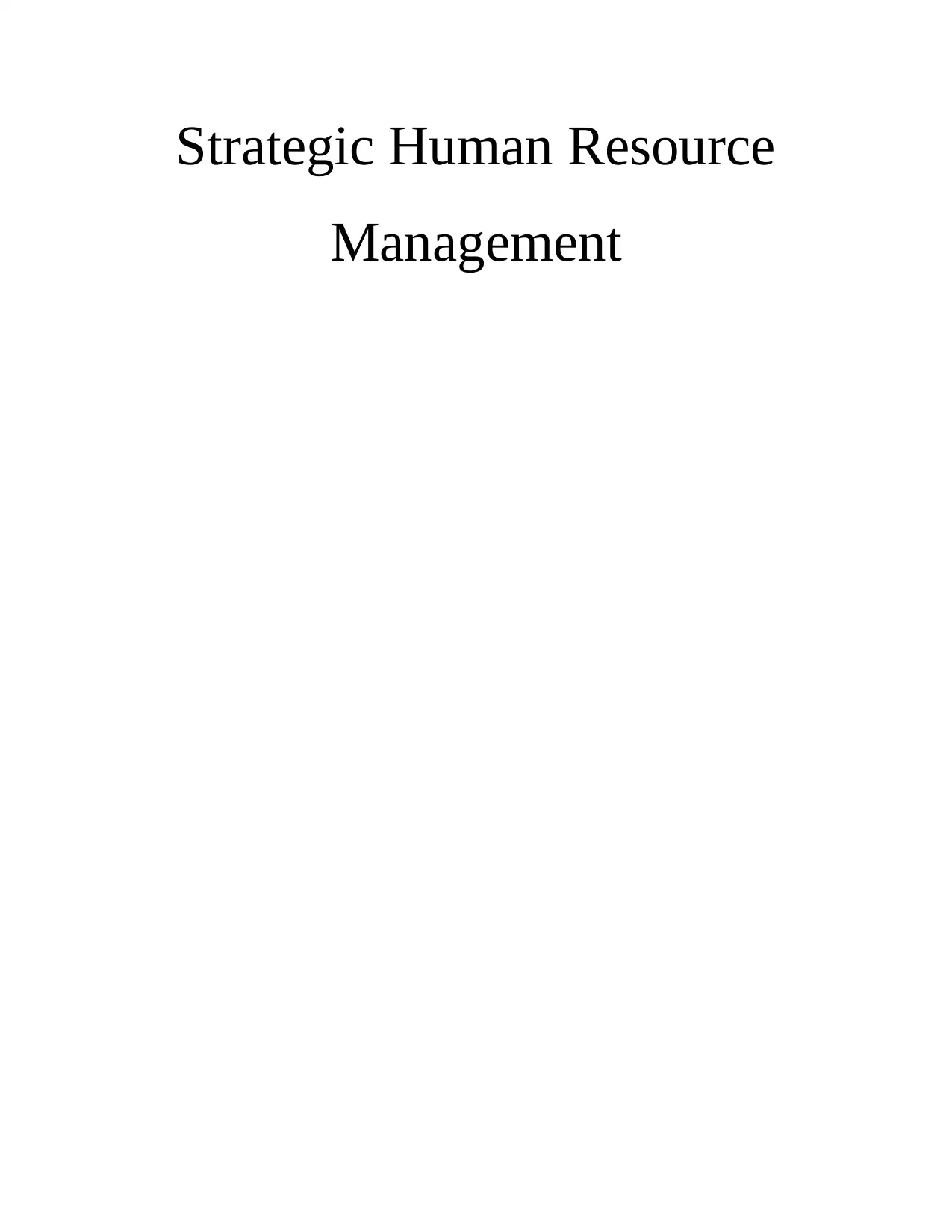
Strategic Human Resource
Management
Management
Paraphrase This Document
Need a fresh take? Get an instant paraphrase of this document with our AI Paraphraser
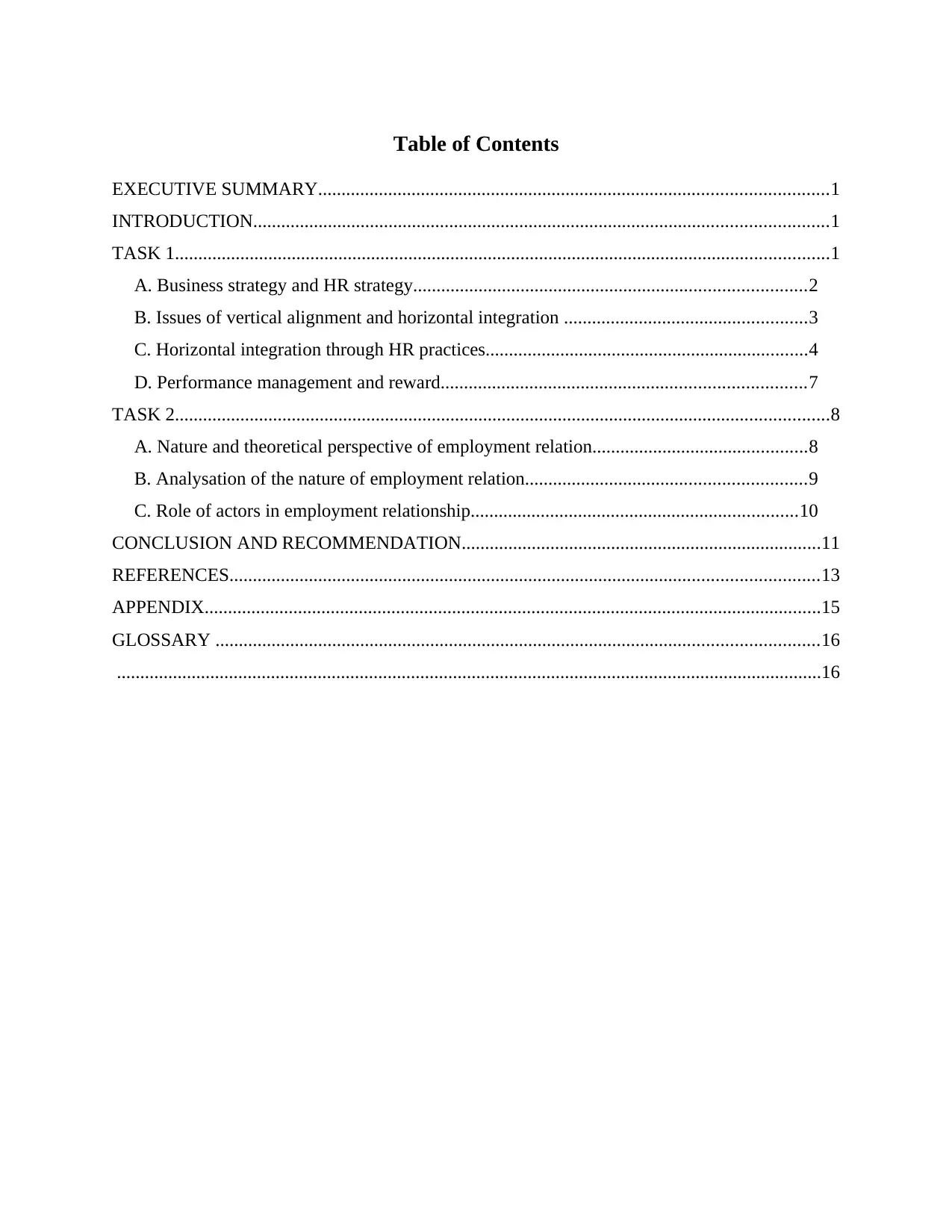
Table of Contents
EXECUTIVE SUMMARY.............................................................................................................1
INTRODUCTION...........................................................................................................................1
TASK 1............................................................................................................................................1
A. Business strategy and HR strategy....................................................................................2
B. Issues of vertical alignment and horizontal integration ....................................................3
C. Horizontal integration through HR practices.....................................................................4
D. Performance management and reward..............................................................................7
TASK 2............................................................................................................................................8
A. Nature and theoretical perspective of employment relation..............................................8
B. Analysation of the nature of employment relation............................................................9
C. Role of actors in employment relationship......................................................................10
CONCLUSION AND RECOMMENDATION.............................................................................11
REFERENCES..............................................................................................................................13
APPENDIX....................................................................................................................................15
GLOSSARY .................................................................................................................................16
.......................................................................................................................................................16
EXECUTIVE SUMMARY.............................................................................................................1
INTRODUCTION...........................................................................................................................1
TASK 1............................................................................................................................................1
A. Business strategy and HR strategy....................................................................................2
B. Issues of vertical alignment and horizontal integration ....................................................3
C. Horizontal integration through HR practices.....................................................................4
D. Performance management and reward..............................................................................7
TASK 2............................................................................................................................................8
A. Nature and theoretical perspective of employment relation..............................................8
B. Analysation of the nature of employment relation............................................................9
C. Role of actors in employment relationship......................................................................10
CONCLUSION AND RECOMMENDATION.............................................................................11
REFERENCES..............................................................................................................................13
APPENDIX....................................................................................................................................15
GLOSSARY .................................................................................................................................16
.......................................................................................................................................................16

⊘ This is a preview!⊘
Do you want full access?
Subscribe today to unlock all pages.

Trusted by 1+ million students worldwide
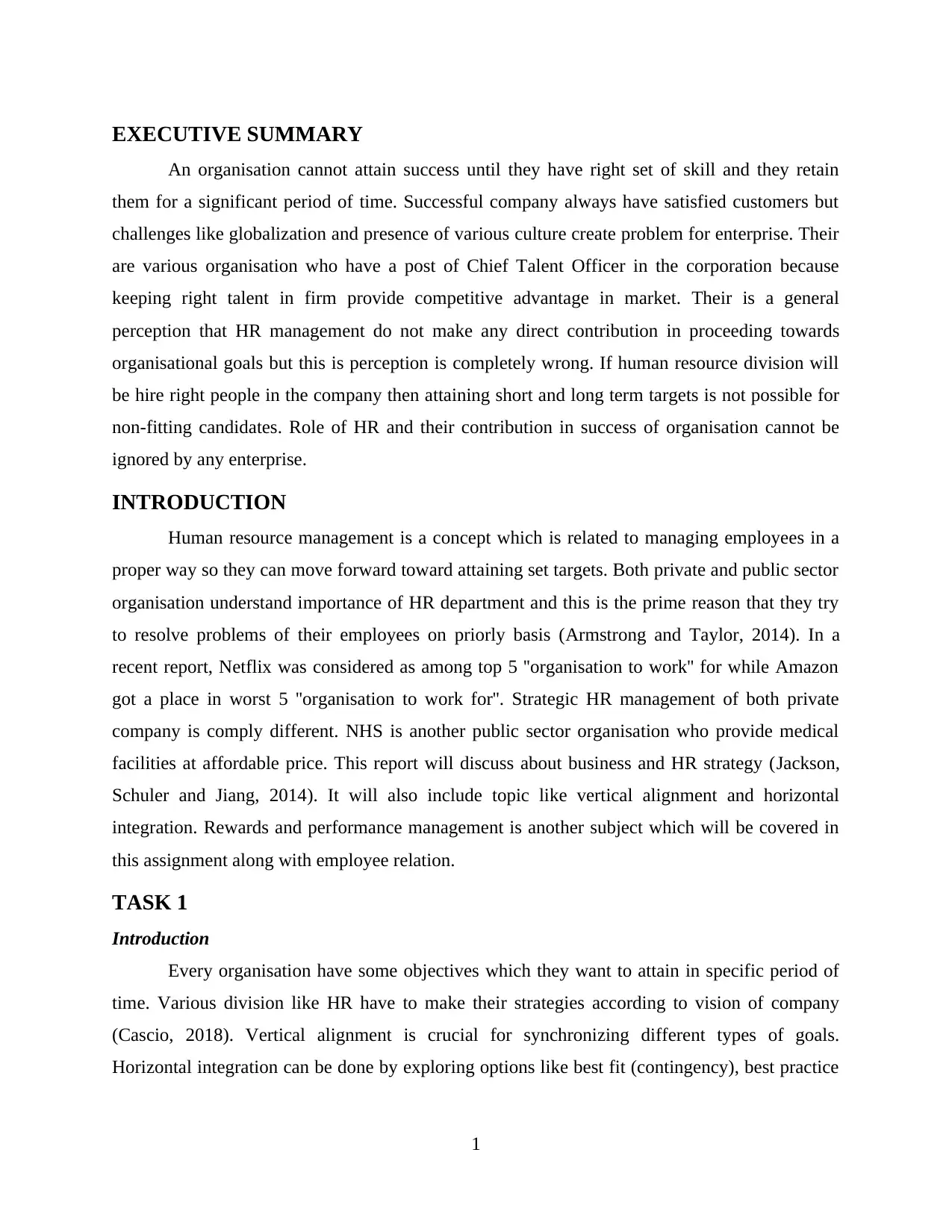
EXECUTIVE SUMMARY
An organisation cannot attain success until they have right set of skill and they retain
them for a significant period of time. Successful company always have satisfied customers but
challenges like globalization and presence of various culture create problem for enterprise. Their
are various organisation who have a post of Chief Talent Officer in the corporation because
keeping right talent in firm provide competitive advantage in market. Their is a general
perception that HR management do not make any direct contribution in proceeding towards
organisational goals but this is perception is completely wrong. If human resource division will
be hire right people in the company then attaining short and long term targets is not possible for
non-fitting candidates. Role of HR and their contribution in success of organisation cannot be
ignored by any enterprise.
INTRODUCTION
Human resource management is a concept which is related to managing employees in a
proper way so they can move forward toward attaining set targets. Both private and public sector
organisation understand importance of HR department and this is the prime reason that they try
to resolve problems of their employees on priorly basis (Armstrong and Taylor, 2014). In a
recent report, Netflix was considered as among top 5 ''organisation to work'' for while Amazon
got a place in worst 5 ''organisation to work for''. Strategic HR management of both private
company is comply different. NHS is another public sector organisation who provide medical
facilities at affordable price. This report will discuss about business and HR strategy (Jackson,
Schuler and Jiang, 2014). It will also include topic like vertical alignment and horizontal
integration. Rewards and performance management is another subject which will be covered in
this assignment along with employee relation.
TASK 1
Introduction
Every organisation have some objectives which they want to attain in specific period of
time. Various division like HR have to make their strategies according to vision of company
(Cascio, 2018). Vertical alignment is crucial for synchronizing different types of goals.
Horizontal integration can be done by exploring options like best fit (contingency), best practice
1
An organisation cannot attain success until they have right set of skill and they retain
them for a significant period of time. Successful company always have satisfied customers but
challenges like globalization and presence of various culture create problem for enterprise. Their
are various organisation who have a post of Chief Talent Officer in the corporation because
keeping right talent in firm provide competitive advantage in market. Their is a general
perception that HR management do not make any direct contribution in proceeding towards
organisational goals but this is perception is completely wrong. If human resource division will
be hire right people in the company then attaining short and long term targets is not possible for
non-fitting candidates. Role of HR and their contribution in success of organisation cannot be
ignored by any enterprise.
INTRODUCTION
Human resource management is a concept which is related to managing employees in a
proper way so they can move forward toward attaining set targets. Both private and public sector
organisation understand importance of HR department and this is the prime reason that they try
to resolve problems of their employees on priorly basis (Armstrong and Taylor, 2014). In a
recent report, Netflix was considered as among top 5 ''organisation to work'' for while Amazon
got a place in worst 5 ''organisation to work for''. Strategic HR management of both private
company is comply different. NHS is another public sector organisation who provide medical
facilities at affordable price. This report will discuss about business and HR strategy (Jackson,
Schuler and Jiang, 2014). It will also include topic like vertical alignment and horizontal
integration. Rewards and performance management is another subject which will be covered in
this assignment along with employee relation.
TASK 1
Introduction
Every organisation have some objectives which they want to attain in specific period of
time. Various division like HR have to make their strategies according to vision of company
(Cascio, 2018). Vertical alignment is crucial for synchronizing different types of goals.
Horizontal integration can be done by exploring options like best fit (contingency), best practice
1
Paraphrase This Document
Need a fresh take? Get an instant paraphrase of this document with our AI Paraphraser
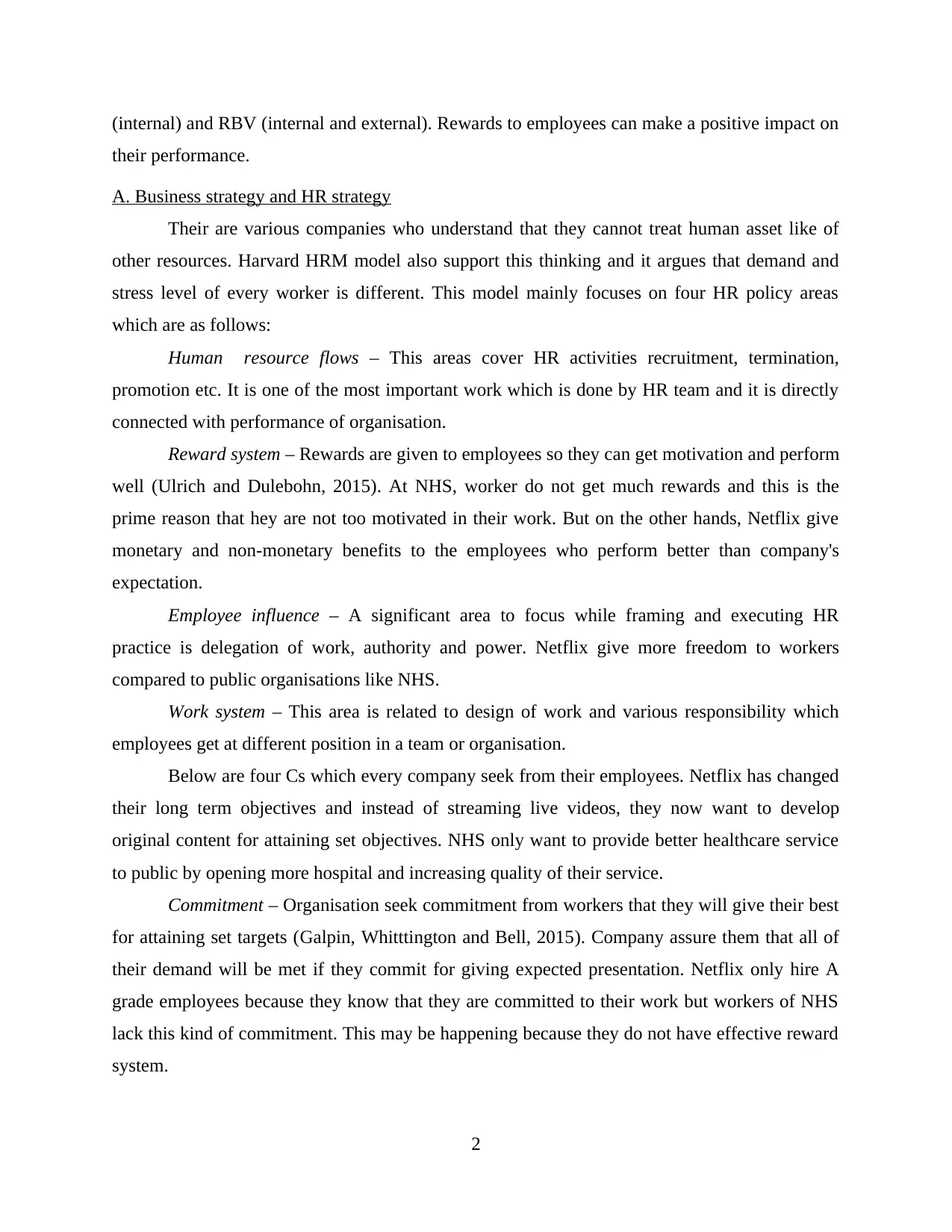
(internal) and RBV (internal and external). Rewards to employees can make a positive impact on
their performance.
A. Business strategy and HR strategy
Their are various companies who understand that they cannot treat human asset like of
other resources. Harvard HRM model also support this thinking and it argues that demand and
stress level of every worker is different. This model mainly focuses on four HR policy areas
which are as follows:
Human resource flows – This areas cover HR activities recruitment, termination,
promotion etc. It is one of the most important work which is done by HR team and it is directly
connected with performance of organisation.
Reward system – Rewards are given to employees so they can get motivation and perform
well (Ulrich and Dulebohn, 2015). At NHS, worker do not get much rewards and this is the
prime reason that hey are not too motivated in their work. But on the other hands, Netflix give
monetary and non-monetary benefits to the employees who perform better than company's
expectation.
Employee influence – A significant area to focus while framing and executing HR
practice is delegation of work, authority and power. Netflix give more freedom to workers
compared to public organisations like NHS.
Work system – This area is related to design of work and various responsibility which
employees get at different position in a team or organisation.
Below are four Cs which every company seek from their employees. Netflix has changed
their long term objectives and instead of streaming live videos, they now want to develop
original content for attaining set objectives. NHS only want to provide better healthcare service
to public by opening more hospital and increasing quality of their service.
Commitment – Organisation seek commitment from workers that they will give their best
for attaining set targets (Galpin, Whitttington and Bell, 2015). Company assure them that all of
their demand will be met if they commit for giving expected presentation. Netflix only hire A
grade employees because they know that they are committed to their work but workers of NHS
lack this kind of commitment. This may be happening because they do not have effective reward
system.
2
their performance.
A. Business strategy and HR strategy
Their are various companies who understand that they cannot treat human asset like of
other resources. Harvard HRM model also support this thinking and it argues that demand and
stress level of every worker is different. This model mainly focuses on four HR policy areas
which are as follows:
Human resource flows – This areas cover HR activities recruitment, termination,
promotion etc. It is one of the most important work which is done by HR team and it is directly
connected with performance of organisation.
Reward system – Rewards are given to employees so they can get motivation and perform
well (Ulrich and Dulebohn, 2015). At NHS, worker do not get much rewards and this is the
prime reason that hey are not too motivated in their work. But on the other hands, Netflix give
monetary and non-monetary benefits to the employees who perform better than company's
expectation.
Employee influence – A significant area to focus while framing and executing HR
practice is delegation of work, authority and power. Netflix give more freedom to workers
compared to public organisations like NHS.
Work system – This area is related to design of work and various responsibility which
employees get at different position in a team or organisation.
Below are four Cs which every company seek from their employees. Netflix has changed
their long term objectives and instead of streaming live videos, they now want to develop
original content for attaining set objectives. NHS only want to provide better healthcare service
to public by opening more hospital and increasing quality of their service.
Commitment – Organisation seek commitment from workers that they will give their best
for attaining set targets (Galpin, Whitttington and Bell, 2015). Company assure them that all of
their demand will be met if they commit for giving expected presentation. Netflix only hire A
grade employees because they know that they are committed to their work but workers of NHS
lack this kind of commitment. This may be happening because they do not have effective reward
system.
2
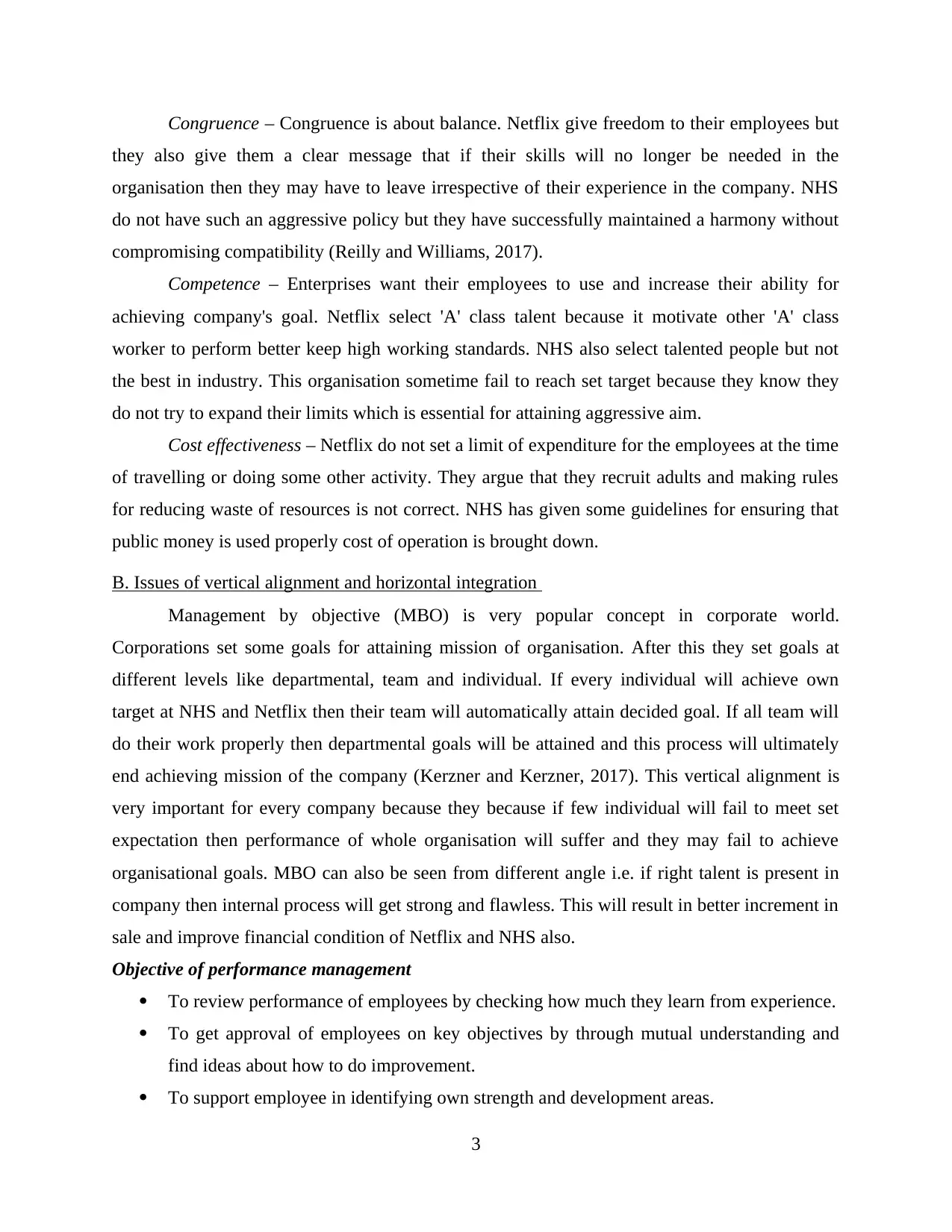
Congruence – Congruence is about balance. Netflix give freedom to their employees but
they also give them a clear message that if their skills will no longer be needed in the
organisation then they may have to leave irrespective of their experience in the company. NHS
do not have such an aggressive policy but they have successfully maintained a harmony without
compromising compatibility (Reilly and Williams, 2017).
Competence – Enterprises want their employees to use and increase their ability for
achieving company's goal. Netflix select 'A' class talent because it motivate other 'A' class
worker to perform better keep high working standards. NHS also select talented people but not
the best in industry. This organisation sometime fail to reach set target because they know they
do not try to expand their limits which is essential for attaining aggressive aim.
Cost effectiveness – Netflix do not set a limit of expenditure for the employees at the time
of travelling or doing some other activity. They argue that they recruit adults and making rules
for reducing waste of resources is not correct. NHS has given some guidelines for ensuring that
public money is used properly cost of operation is brought down.
B. Issues of vertical alignment and horizontal integration
Management by objective (MBO) is very popular concept in corporate world.
Corporations set some goals for attaining mission of organisation. After this they set goals at
different levels like departmental, team and individual. If every individual will achieve own
target at NHS and Netflix then their team will automatically attain decided goal. If all team will
do their work properly then departmental goals will be attained and this process will ultimately
end achieving mission of the company (Kerzner and Kerzner, 2017). This vertical alignment is
very important for every company because they because if few individual will fail to meet set
expectation then performance of whole organisation will suffer and they may fail to achieve
organisational goals. MBO can also be seen from different angle i.e. if right talent is present in
company then internal process will get strong and flawless. This will result in better increment in
sale and improve financial condition of Netflix and NHS also.
Objective of performance management
To review performance of employees by checking how much they learn from experience.
To get approval of employees on key objectives by through mutual understanding and
find ideas about how to do improvement.
To support employee in identifying own strength and development areas.
3
they also give them a clear message that if their skills will no longer be needed in the
organisation then they may have to leave irrespective of their experience in the company. NHS
do not have such an aggressive policy but they have successfully maintained a harmony without
compromising compatibility (Reilly and Williams, 2017).
Competence – Enterprises want their employees to use and increase their ability for
achieving company's goal. Netflix select 'A' class talent because it motivate other 'A' class
worker to perform better keep high working standards. NHS also select talented people but not
the best in industry. This organisation sometime fail to reach set target because they know they
do not try to expand their limits which is essential for attaining aggressive aim.
Cost effectiveness – Netflix do not set a limit of expenditure for the employees at the time
of travelling or doing some other activity. They argue that they recruit adults and making rules
for reducing waste of resources is not correct. NHS has given some guidelines for ensuring that
public money is used properly cost of operation is brought down.
B. Issues of vertical alignment and horizontal integration
Management by objective (MBO) is very popular concept in corporate world.
Corporations set some goals for attaining mission of organisation. After this they set goals at
different levels like departmental, team and individual. If every individual will achieve own
target at NHS and Netflix then their team will automatically attain decided goal. If all team will
do their work properly then departmental goals will be attained and this process will ultimately
end achieving mission of the company (Kerzner and Kerzner, 2017). This vertical alignment is
very important for every company because they because if few individual will fail to meet set
expectation then performance of whole organisation will suffer and they may fail to achieve
organisational goals. MBO can also be seen from different angle i.e. if right talent is present in
company then internal process will get strong and flawless. This will result in better increment in
sale and improve financial condition of Netflix and NHS also.
Objective of performance management
To review performance of employees by checking how much they learn from experience.
To get approval of employees on key objectives by through mutual understanding and
find ideas about how to do improvement.
To support employee in identifying own strength and development areas.
3
⊘ This is a preview!⊘
Do you want full access?
Subscribe today to unlock all pages.

Trusted by 1+ million students worldwide
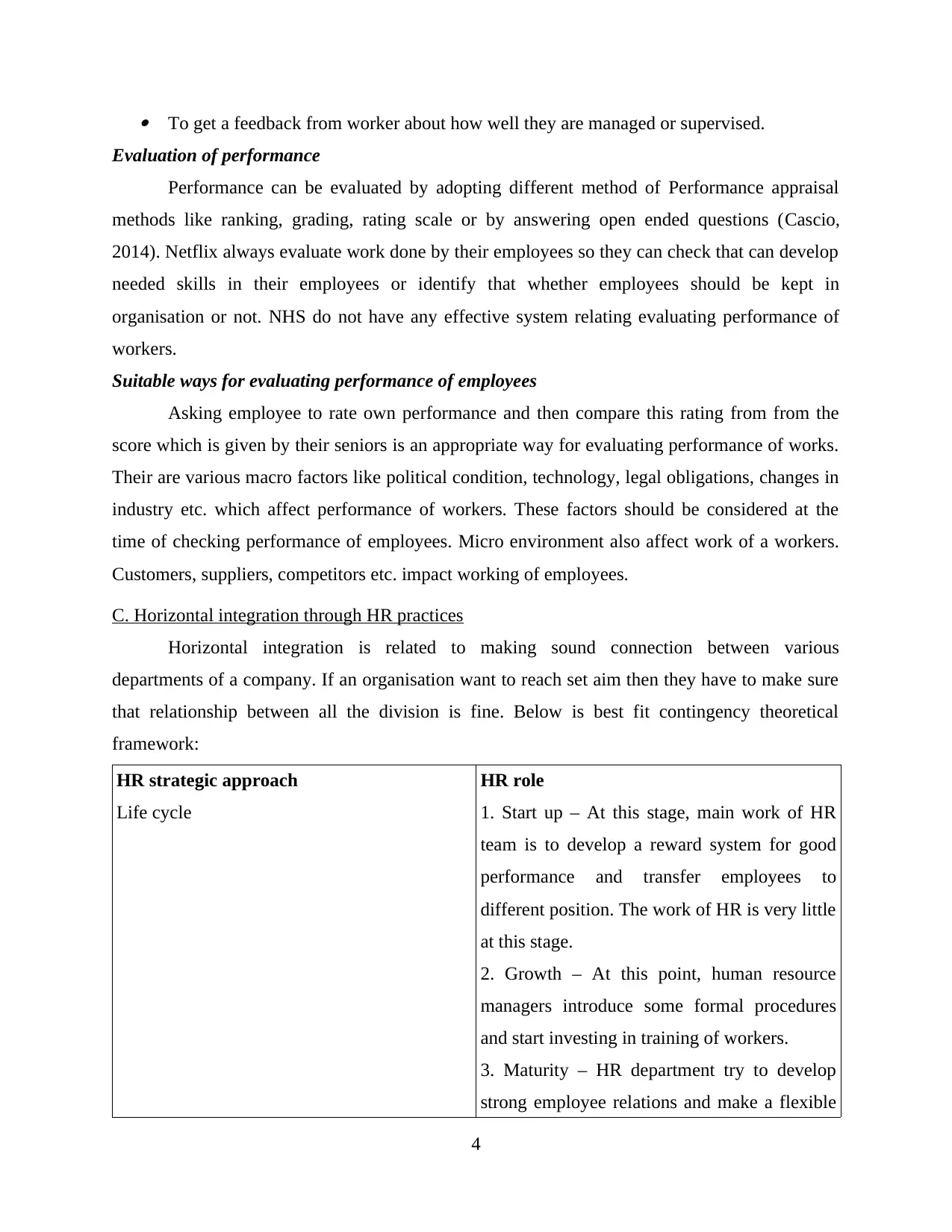
To get a feedback from worker about how well they are managed or supervised.
Evaluation of performance
Performance can be evaluated by adopting different method of Performance appraisal
methods like ranking, grading, rating scale or by answering open ended questions (Cascio,
2014). Netflix always evaluate work done by their employees so they can check that can develop
needed skills in their employees or identify that whether employees should be kept in
organisation or not. NHS do not have any effective system relating evaluating performance of
workers.
Suitable ways for evaluating performance of employees
Asking employee to rate own performance and then compare this rating from from the
score which is given by their seniors is an appropriate way for evaluating performance of works.
Their are various macro factors like political condition, technology, legal obligations, changes in
industry etc. which affect performance of workers. These factors should be considered at the
time of checking performance of employees. Micro environment also affect work of a workers.
Customers, suppliers, competitors etc. impact working of employees.
C. Horizontal integration through HR practices
Horizontal integration is related to making sound connection between various
departments of a company. If an organisation want to reach set aim then they have to make sure
that relationship between all the division is fine. Below is best fit contingency theoretical
framework:
HR strategic approach
Life cycle
HR role
1. Start up – At this stage, main work of HR
team is to develop a reward system for good
performance and transfer employees to
different position. The work of HR is very little
at this stage.
2. Growth – At this point, human resource
managers introduce some formal procedures
and start investing in training of workers.
3. Maturity – HR department try to develop
strong employee relations and make a flexible
4
Evaluation of performance
Performance can be evaluated by adopting different method of Performance appraisal
methods like ranking, grading, rating scale or by answering open ended questions (Cascio,
2014). Netflix always evaluate work done by their employees so they can check that can develop
needed skills in their employees or identify that whether employees should be kept in
organisation or not. NHS do not have any effective system relating evaluating performance of
workers.
Suitable ways for evaluating performance of employees
Asking employee to rate own performance and then compare this rating from from the
score which is given by their seniors is an appropriate way for evaluating performance of works.
Their are various macro factors like political condition, technology, legal obligations, changes in
industry etc. which affect performance of workers. These factors should be considered at the
time of checking performance of employees. Micro environment also affect work of a workers.
Customers, suppliers, competitors etc. impact working of employees.
C. Horizontal integration through HR practices
Horizontal integration is related to making sound connection between various
departments of a company. If an organisation want to reach set aim then they have to make sure
that relationship between all the division is fine. Below is best fit contingency theoretical
framework:
HR strategic approach
Life cycle
HR role
1. Start up – At this stage, main work of HR
team is to develop a reward system for good
performance and transfer employees to
different position. The work of HR is very little
at this stage.
2. Growth – At this point, human resource
managers introduce some formal procedures
and start investing in training of workers.
3. Maturity – HR department try to develop
strong employee relations and make a flexible
4
Paraphrase This Document
Need a fresh take? Get an instant paraphrase of this document with our AI Paraphraser
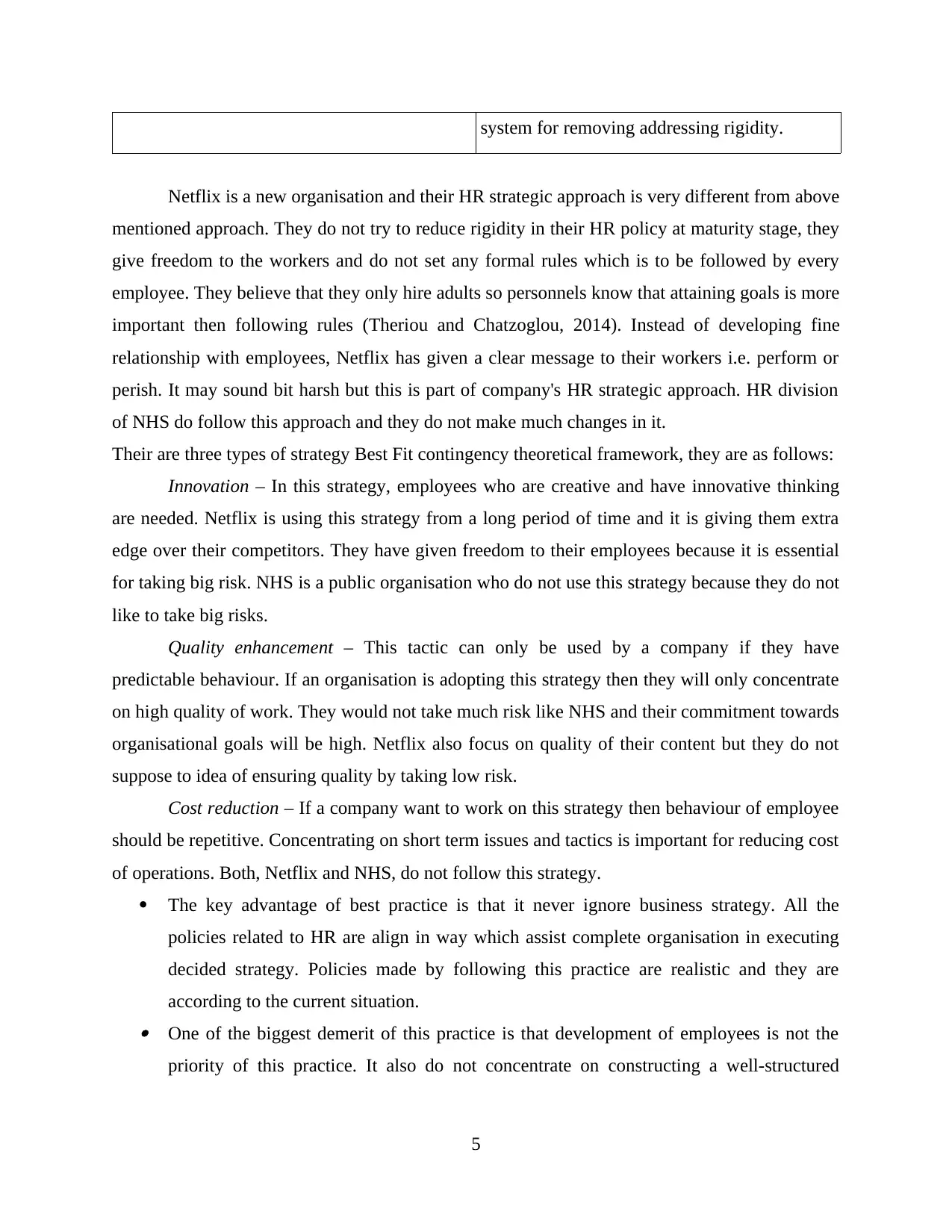
system for removing addressing rigidity.
Netflix is a new organisation and their HR strategic approach is very different from above
mentioned approach. They do not try to reduce rigidity in their HR policy at maturity stage, they
give freedom to the workers and do not set any formal rules which is to be followed by every
employee. They believe that they only hire adults so personnels know that attaining goals is more
important then following rules (Theriou and Chatzoglou, 2014). Instead of developing fine
relationship with employees, Netflix has given a clear message to their workers i.e. perform or
perish. It may sound bit harsh but this is part of company's HR strategic approach. HR division
of NHS do follow this approach and they do not make much changes in it.
Their are three types of strategy Best Fit contingency theoretical framework, they are as follows:
Innovation – In this strategy, employees who are creative and have innovative thinking
are needed. Netflix is using this strategy from a long period of time and it is giving them extra
edge over their competitors. They have given freedom to their employees because it is essential
for taking big risk. NHS is a public organisation who do not use this strategy because they do not
like to take big risks.
Quality enhancement – This tactic can only be used by a company if they have
predictable behaviour. If an organisation is adopting this strategy then they will only concentrate
on high quality of work. They would not take much risk like NHS and their commitment towards
organisational goals will be high. Netflix also focus on quality of their content but they do not
suppose to idea of ensuring quality by taking low risk.
Cost reduction – If a company want to work on this strategy then behaviour of employee
should be repetitive. Concentrating on short term issues and tactics is important for reducing cost
of operations. Both, Netflix and NHS, do not follow this strategy.
The key advantage of best practice is that it never ignore business strategy. All the
policies related to HR are align in way which assist complete organisation in executing
decided strategy. Policies made by following this practice are realistic and they are
according to the current situation. One of the biggest demerit of this practice is that development of employees is not the
priority of this practice. It also do not concentrate on constructing a well-structured
5
Netflix is a new organisation and their HR strategic approach is very different from above
mentioned approach. They do not try to reduce rigidity in their HR policy at maturity stage, they
give freedom to the workers and do not set any formal rules which is to be followed by every
employee. They believe that they only hire adults so personnels know that attaining goals is more
important then following rules (Theriou and Chatzoglou, 2014). Instead of developing fine
relationship with employees, Netflix has given a clear message to their workers i.e. perform or
perish. It may sound bit harsh but this is part of company's HR strategic approach. HR division
of NHS do follow this approach and they do not make much changes in it.
Their are three types of strategy Best Fit contingency theoretical framework, they are as follows:
Innovation – In this strategy, employees who are creative and have innovative thinking
are needed. Netflix is using this strategy from a long period of time and it is giving them extra
edge over their competitors. They have given freedom to their employees because it is essential
for taking big risk. NHS is a public organisation who do not use this strategy because they do not
like to take big risks.
Quality enhancement – This tactic can only be used by a company if they have
predictable behaviour. If an organisation is adopting this strategy then they will only concentrate
on high quality of work. They would not take much risk like NHS and their commitment towards
organisational goals will be high. Netflix also focus on quality of their content but they do not
suppose to idea of ensuring quality by taking low risk.
Cost reduction – If a company want to work on this strategy then behaviour of employee
should be repetitive. Concentrating on short term issues and tactics is important for reducing cost
of operations. Both, Netflix and NHS, do not follow this strategy.
The key advantage of best practice is that it never ignore business strategy. All the
policies related to HR are align in way which assist complete organisation in executing
decided strategy. Policies made by following this practice are realistic and they are
according to the current situation. One of the biggest demerit of this practice is that development of employees is not the
priority of this practice. It also do not concentrate on constructing a well-structured
5

selection procedure. If recruitment process is not up to mark then both organisation may
fail to attain their objectives.
Best Practice (Internal)
This approach argue that there are few HR activities which can provide extra edge to
every company who in whatever the industry they are operating. Netflix has developed a system
where they do not make rules for their employees and instead ask them to manage things at own
level. This strategy do not get affected by change in external environment. Netflix is applying
this practice by hiring 'A' class employees. They feel that if instead of giving free food or
travelling expenses to employees for motivating them, they should recruit talented people in the
firm so employees can get a favourable and better working environment and learn more things
about their work (Hauff, Alewell and Hansen, 2014). NHS do not have any specific HR strategy
and they have some standard procedure regarding training of employees which they follow for
without considering any external factor.
Key merit of adopting this approach is that it encourages workers to perform well by
fulfilling demand of workers and setting goals by discussing with them. It ultimately
ensure high commitment from the side of employees. Another advantage of this practice
is that it reduce absenteeism and increase productivity of worker. This approach has various limitations. On one side it argues that team working is
important but on other side it also promote individual performances. These two
statements contradict each other. High commitment management system include different
kind of complexities and need lot of planning.
RBV (Internal and External)
Resource based view (RBV) is an effective and realistic approach. Instead argues that
every company should first check availability of resources then develop policy accordingly.
Their is no doubt that this is realistic approach but this does not means that it is perfect. Netflix
has financial resources and this is why they are able to hire best people from different filed. NHS
have their own resources and they use it accordingly. This kind of practice urges a company to
focus on their internal resources instead of analysing external environment.
Advantage of this practice is that assist HR managers is understanding the reason behind
why resources are scare and valuable. Another key merit of this approach is that provide
uniqueness to an organisation by managing resources in proper way.
6
fail to attain their objectives.
Best Practice (Internal)
This approach argue that there are few HR activities which can provide extra edge to
every company who in whatever the industry they are operating. Netflix has developed a system
where they do not make rules for their employees and instead ask them to manage things at own
level. This strategy do not get affected by change in external environment. Netflix is applying
this practice by hiring 'A' class employees. They feel that if instead of giving free food or
travelling expenses to employees for motivating them, they should recruit talented people in the
firm so employees can get a favourable and better working environment and learn more things
about their work (Hauff, Alewell and Hansen, 2014). NHS do not have any specific HR strategy
and they have some standard procedure regarding training of employees which they follow for
without considering any external factor.
Key merit of adopting this approach is that it encourages workers to perform well by
fulfilling demand of workers and setting goals by discussing with them. It ultimately
ensure high commitment from the side of employees. Another advantage of this practice
is that it reduce absenteeism and increase productivity of worker. This approach has various limitations. On one side it argues that team working is
important but on other side it also promote individual performances. These two
statements contradict each other. High commitment management system include different
kind of complexities and need lot of planning.
RBV (Internal and External)
Resource based view (RBV) is an effective and realistic approach. Instead argues that
every company should first check availability of resources then develop policy accordingly.
Their is no doubt that this is realistic approach but this does not means that it is perfect. Netflix
has financial resources and this is why they are able to hire best people from different filed. NHS
have their own resources and they use it accordingly. This kind of practice urges a company to
focus on their internal resources instead of analysing external environment.
Advantage of this practice is that assist HR managers is understanding the reason behind
why resources are scare and valuable. Another key merit of this approach is that provide
uniqueness to an organisation by managing resources in proper way.
6
⊘ This is a preview!⊘
Do you want full access?
Subscribe today to unlock all pages.

Trusted by 1+ million students worldwide
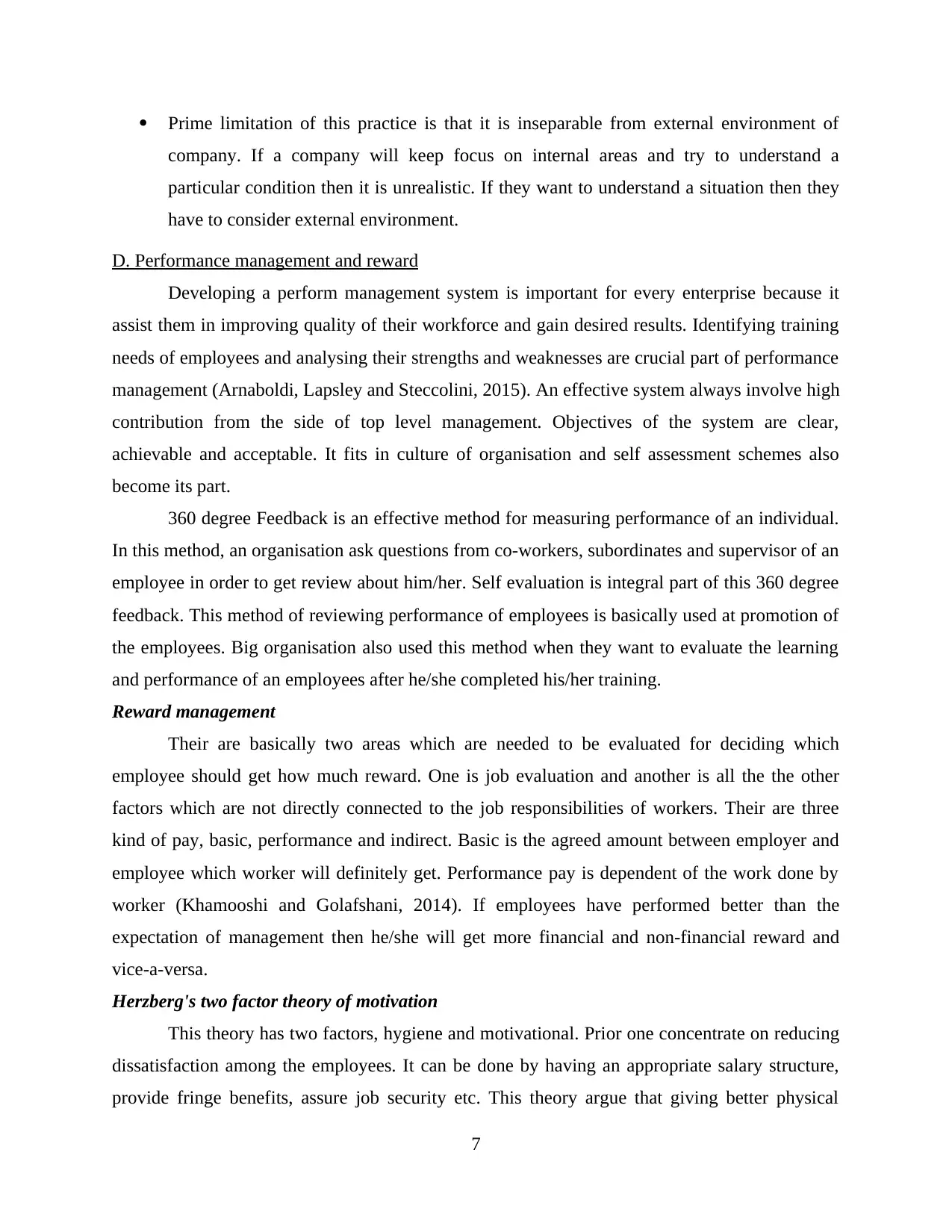
Prime limitation of this practice is that it is inseparable from external environment of
company. If a company will keep focus on internal areas and try to understand a
particular condition then it is unrealistic. If they want to understand a situation then they
have to consider external environment.
D. Performance management and reward
Developing a perform management system is important for every enterprise because it
assist them in improving quality of their workforce and gain desired results. Identifying training
needs of employees and analysing their strengths and weaknesses are crucial part of performance
management (Arnaboldi, Lapsley and Steccolini, 2015). An effective system always involve high
contribution from the side of top level management. Objectives of the system are clear,
achievable and acceptable. It fits in culture of organisation and self assessment schemes also
become its part.
360 degree Feedback is an effective method for measuring performance of an individual.
In this method, an organisation ask questions from co-workers, subordinates and supervisor of an
employee in order to get review about him/her. Self evaluation is integral part of this 360 degree
feedback. This method of reviewing performance of employees is basically used at promotion of
the employees. Big organisation also used this method when they want to evaluate the learning
and performance of an employees after he/she completed his/her training.
Reward management
Their are basically two areas which are needed to be evaluated for deciding which
employee should get how much reward. One is job evaluation and another is all the the other
factors which are not directly connected to the job responsibilities of workers. Their are three
kind of pay, basic, performance and indirect. Basic is the agreed amount between employer and
employee which worker will definitely get. Performance pay is dependent of the work done by
worker (Khamooshi and Golafshani, 2014). If employees have performed better than the
expectation of management then he/she will get more financial and non-financial reward and
vice-a-versa.
Herzberg's two factor theory of motivation
This theory has two factors, hygiene and motivational. Prior one concentrate on reducing
dissatisfaction among the employees. It can be done by having an appropriate salary structure,
provide fringe benefits, assure job security etc. This theory argue that giving better physical
7
company. If a company will keep focus on internal areas and try to understand a
particular condition then it is unrealistic. If they want to understand a situation then they
have to consider external environment.
D. Performance management and reward
Developing a perform management system is important for every enterprise because it
assist them in improving quality of their workforce and gain desired results. Identifying training
needs of employees and analysing their strengths and weaknesses are crucial part of performance
management (Arnaboldi, Lapsley and Steccolini, 2015). An effective system always involve high
contribution from the side of top level management. Objectives of the system are clear,
achievable and acceptable. It fits in culture of organisation and self assessment schemes also
become its part.
360 degree Feedback is an effective method for measuring performance of an individual.
In this method, an organisation ask questions from co-workers, subordinates and supervisor of an
employee in order to get review about him/her. Self evaluation is integral part of this 360 degree
feedback. This method of reviewing performance of employees is basically used at promotion of
the employees. Big organisation also used this method when they want to evaluate the learning
and performance of an employees after he/she completed his/her training.
Reward management
Their are basically two areas which are needed to be evaluated for deciding which
employee should get how much reward. One is job evaluation and another is all the the other
factors which are not directly connected to the job responsibilities of workers. Their are three
kind of pay, basic, performance and indirect. Basic is the agreed amount between employer and
employee which worker will definitely get. Performance pay is dependent of the work done by
worker (Khamooshi and Golafshani, 2014). If employees have performed better than the
expectation of management then he/she will get more financial and non-financial reward and
vice-a-versa.
Herzberg's two factor theory of motivation
This theory has two factors, hygiene and motivational. Prior one concentrate on reducing
dissatisfaction among the employees. It can be done by having an appropriate salary structure,
provide fringe benefits, assure job security etc. This theory argue that giving better physical
7
Paraphrase This Document
Need a fresh take? Get an instant paraphrase of this document with our AI Paraphraser
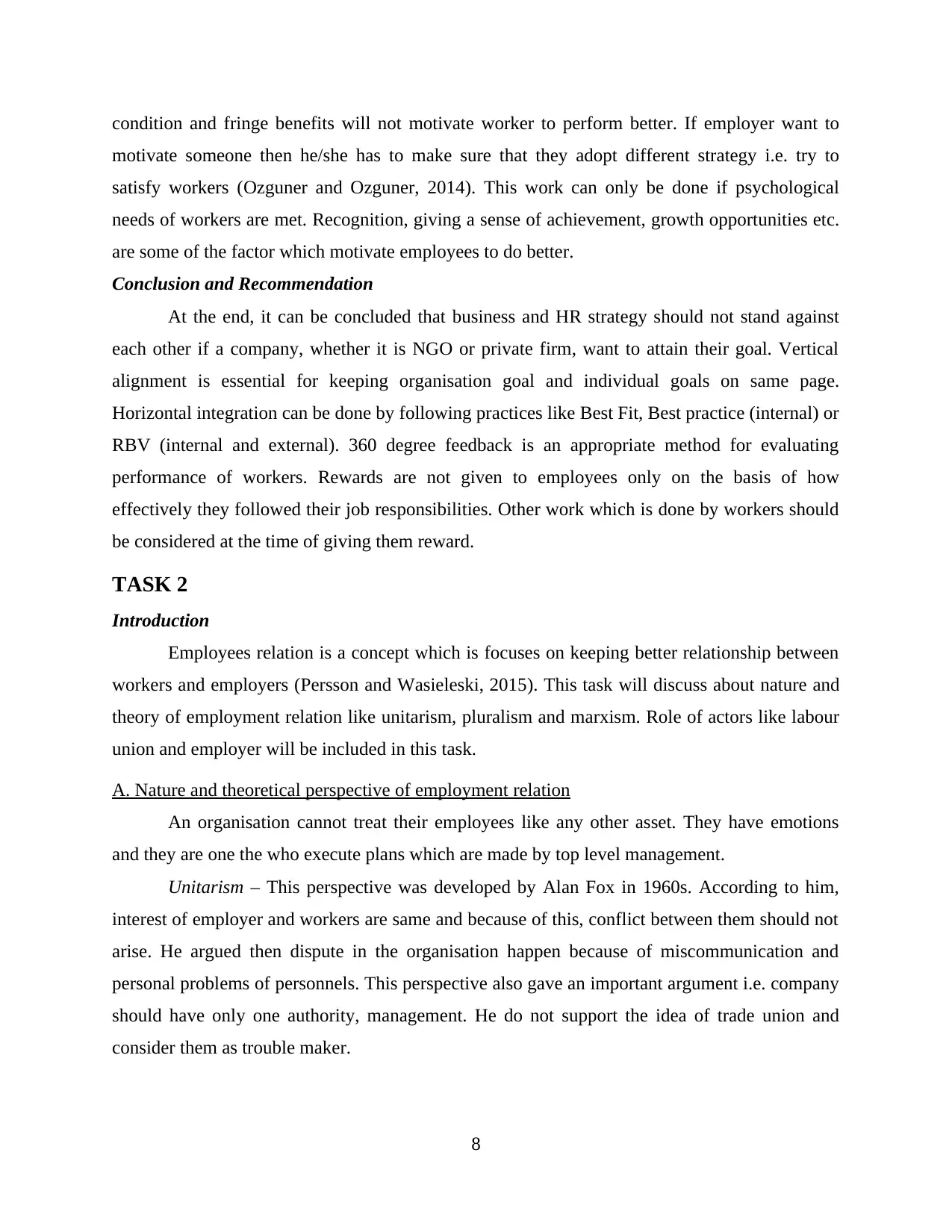
condition and fringe benefits will not motivate worker to perform better. If employer want to
motivate someone then he/she has to make sure that they adopt different strategy i.e. try to
satisfy workers (Ozguner and Ozguner, 2014). This work can only be done if psychological
needs of workers are met. Recognition, giving a sense of achievement, growth opportunities etc.
are some of the factor which motivate employees to do better.
Conclusion and Recommendation
At the end, it can be concluded that business and HR strategy should not stand against
each other if a company, whether it is NGO or private firm, want to attain their goal. Vertical
alignment is essential for keeping organisation goal and individual goals on same page.
Horizontal integration can be done by following practices like Best Fit, Best practice (internal) or
RBV (internal and external). 360 degree feedback is an appropriate method for evaluating
performance of workers. Rewards are not given to employees only on the basis of how
effectively they followed their job responsibilities. Other work which is done by workers should
be considered at the time of giving them reward.
TASK 2
Introduction
Employees relation is a concept which is focuses on keeping better relationship between
workers and employers (Persson and Wasieleski, 2015). This task will discuss about nature and
theory of employment relation like unitarism, pluralism and marxism. Role of actors like labour
union and employer will be included in this task.
A. Nature and theoretical perspective of employment relation
An organisation cannot treat their employees like any other asset. They have emotions
and they are one the who execute plans which are made by top level management.
Unitarism – This perspective was developed by Alan Fox in 1960s. According to him,
interest of employer and workers are same and because of this, conflict between them should not
arise. He argued then dispute in the organisation happen because of miscommunication and
personal problems of personnels. This perspective also gave an important argument i.e. company
should have only one authority, management. He do not support the idea of trade union and
consider them as trouble maker.
8
motivate someone then he/she has to make sure that they adopt different strategy i.e. try to
satisfy workers (Ozguner and Ozguner, 2014). This work can only be done if psychological
needs of workers are met. Recognition, giving a sense of achievement, growth opportunities etc.
are some of the factor which motivate employees to do better.
Conclusion and Recommendation
At the end, it can be concluded that business and HR strategy should not stand against
each other if a company, whether it is NGO or private firm, want to attain their goal. Vertical
alignment is essential for keeping organisation goal and individual goals on same page.
Horizontal integration can be done by following practices like Best Fit, Best practice (internal) or
RBV (internal and external). 360 degree feedback is an appropriate method for evaluating
performance of workers. Rewards are not given to employees only on the basis of how
effectively they followed their job responsibilities. Other work which is done by workers should
be considered at the time of giving them reward.
TASK 2
Introduction
Employees relation is a concept which is focuses on keeping better relationship between
workers and employers (Persson and Wasieleski, 2015). This task will discuss about nature and
theory of employment relation like unitarism, pluralism and marxism. Role of actors like labour
union and employer will be included in this task.
A. Nature and theoretical perspective of employment relation
An organisation cannot treat their employees like any other asset. They have emotions
and they are one the who execute plans which are made by top level management.
Unitarism – This perspective was developed by Alan Fox in 1960s. According to him,
interest of employer and workers are same and because of this, conflict between them should not
arise. He argued then dispute in the organisation happen because of miscommunication and
personal problems of personnels. This perspective also gave an important argument i.e. company
should have only one authority, management. He do not support the idea of trade union and
consider them as trouble maker.
8
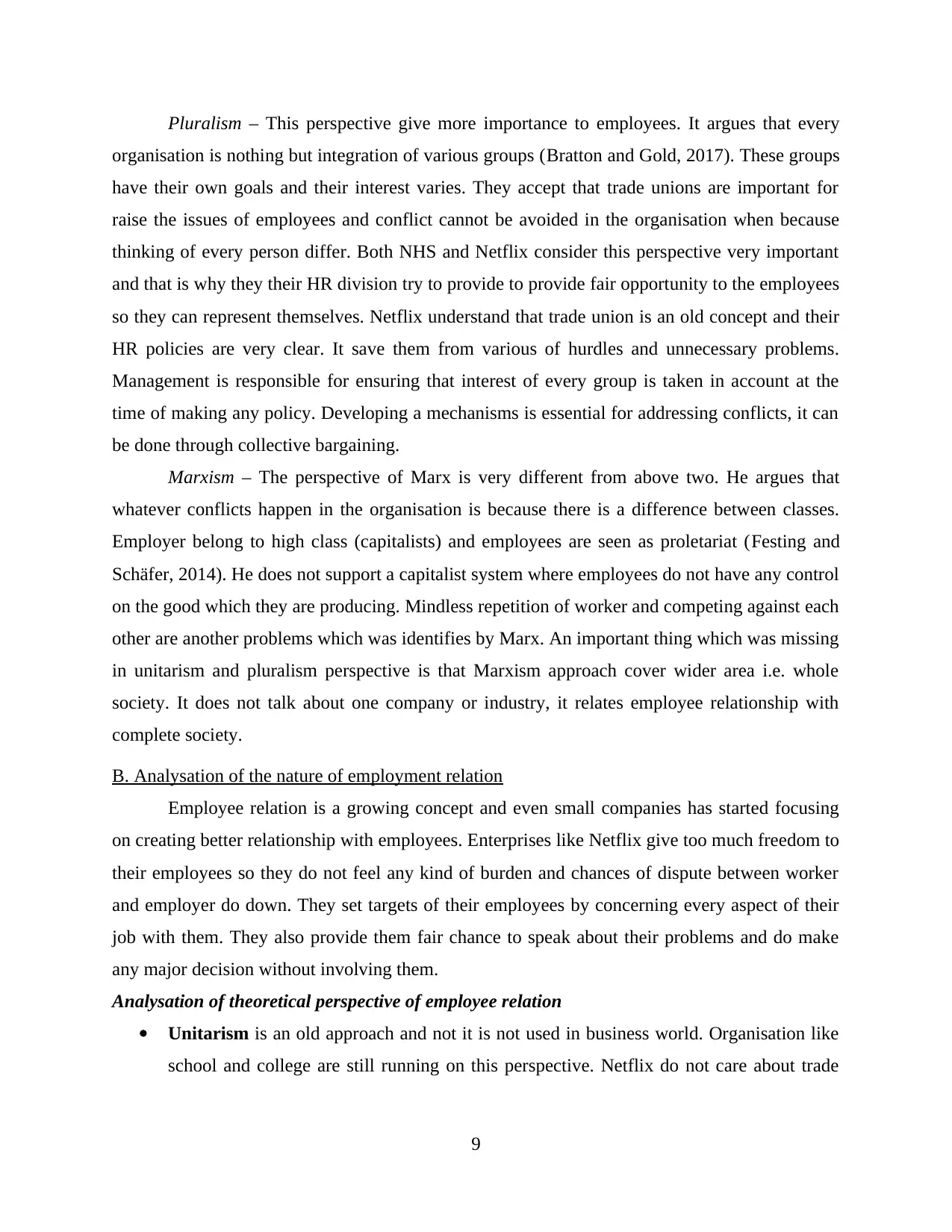
Pluralism – This perspective give more importance to employees. It argues that every
organisation is nothing but integration of various groups (Bratton and Gold, 2017). These groups
have their own goals and their interest varies. They accept that trade unions are important for
raise the issues of employees and conflict cannot be avoided in the organisation when because
thinking of every person differ. Both NHS and Netflix consider this perspective very important
and that is why they their HR division try to provide to provide fair opportunity to the employees
so they can represent themselves. Netflix understand that trade union is an old concept and their
HR policies are very clear. It save them from various of hurdles and unnecessary problems.
Management is responsible for ensuring that interest of every group is taken in account at the
time of making any policy. Developing a mechanisms is essential for addressing conflicts, it can
be done through collective bargaining.
Marxism – The perspective of Marx is very different from above two. He argues that
whatever conflicts happen in the organisation is because there is a difference between classes.
Employer belong to high class (capitalists) and employees are seen as proletariat (Festing and
Schäfer, 2014). He does not support a capitalist system where employees do not have any control
on the good which they are producing. Mindless repetition of worker and competing against each
other are another problems which was identifies by Marx. An important thing which was missing
in unitarism and pluralism perspective is that Marxism approach cover wider area i.e. whole
society. It does not talk about one company or industry, it relates employee relationship with
complete society.
B. Analysation of the nature of employment relation
Employee relation is a growing concept and even small companies has started focusing
on creating better relationship with employees. Enterprises like Netflix give too much freedom to
their employees so they do not feel any kind of burden and chances of dispute between worker
and employer do down. They set targets of their employees by concerning every aspect of their
job with them. They also provide them fair chance to speak about their problems and do make
any major decision without involving them.
Analysation of theoretical perspective of employee relation
Unitarism is an old approach and not it is not used in business world. Organisation like
school and college are still running on this perspective. Netflix do not care about trade
9
organisation is nothing but integration of various groups (Bratton and Gold, 2017). These groups
have their own goals and their interest varies. They accept that trade unions are important for
raise the issues of employees and conflict cannot be avoided in the organisation when because
thinking of every person differ. Both NHS and Netflix consider this perspective very important
and that is why they their HR division try to provide to provide fair opportunity to the employees
so they can represent themselves. Netflix understand that trade union is an old concept and their
HR policies are very clear. It save them from various of hurdles and unnecessary problems.
Management is responsible for ensuring that interest of every group is taken in account at the
time of making any policy. Developing a mechanisms is essential for addressing conflicts, it can
be done through collective bargaining.
Marxism – The perspective of Marx is very different from above two. He argues that
whatever conflicts happen in the organisation is because there is a difference between classes.
Employer belong to high class (capitalists) and employees are seen as proletariat (Festing and
Schäfer, 2014). He does not support a capitalist system where employees do not have any control
on the good which they are producing. Mindless repetition of worker and competing against each
other are another problems which was identifies by Marx. An important thing which was missing
in unitarism and pluralism perspective is that Marxism approach cover wider area i.e. whole
society. It does not talk about one company or industry, it relates employee relationship with
complete society.
B. Analysation of the nature of employment relation
Employee relation is a growing concept and even small companies has started focusing
on creating better relationship with employees. Enterprises like Netflix give too much freedom to
their employees so they do not feel any kind of burden and chances of dispute between worker
and employer do down. They set targets of their employees by concerning every aspect of their
job with them. They also provide them fair chance to speak about their problems and do make
any major decision without involving them.
Analysation of theoretical perspective of employee relation
Unitarism is an old approach and not it is not used in business world. Organisation like
school and college are still running on this perspective. Netflix do not care about trade
9
⊘ This is a preview!⊘
Do you want full access?
Subscribe today to unlock all pages.

Trusted by 1+ million students worldwide
1 out of 19
Related Documents
Your All-in-One AI-Powered Toolkit for Academic Success.
+13062052269
info@desklib.com
Available 24*7 on WhatsApp / Email
![[object Object]](/_next/static/media/star-bottom.7253800d.svg)
Unlock your academic potential
Copyright © 2020–2026 A2Z Services. All Rights Reserved. Developed and managed by ZUCOL.




